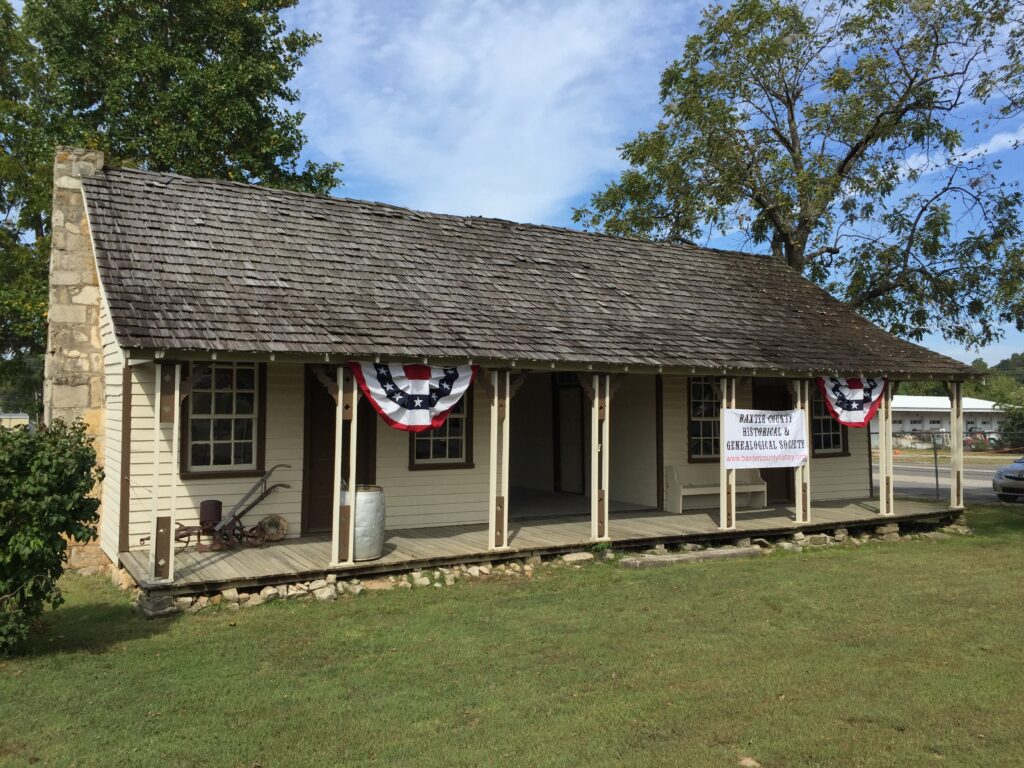The Casey House: a Treasure of the Past

The Casey House is the oldest still-standing structure in Mountain Home, Arkansas, located on the very spot where it was constructed. Built by Col. Randolph Casey in 1858, this two-room “dog-trot” cabin was well designed and snugly constructed. It survived the Civil War in the 1860s, a near-devastating tornado in 1985, and the ravages of time. Most of the building, including the foundation stones, is original, although some new wood was added during repairs after the tornado. The building has stood on the same spot through the settlement of Baxter County, the growth of Mountain Home and the establishment of the fairgrounds just outside the gate. In Casey’s time, several outbuildings surrounded the cabin, but they were taken down long ago.
Casey was following the lead of his younger brother John, a doctor, who earlier had settled on the banks of the North Fork River near pioneer Jacob Wolf. The two-story Wolf House still stands at Norfork and is a much loved historic landmark. Dr. John Casey later married Jacob Wolf’s daughter.
Randolph (usually called Ran) wanted to push further west. At that time, steamboats carried settlers down the North Fork to the White River and as far as Buffalo. From there folks would travel on by wagon, horse back or on foot. At Buffalo, Ran and his mother offloaded their belongings onto a wagon and drove the few miles to Rapp’s Barren, which was a growing settlement (now Mountain Home). There he opened a tiny store, selling mostly salt, sugar, cloth and gunpowder. It also served as the post office. The store is long gone, but the house he built nearby remains. Ran Casey, the story goes, had promised his mother that never again would she have to live in a log cabin. This house is the proof that he kept that promise.
The Casey House is more advanced than the typical cabin of the times, with its two porches, stone fireplace and glasswindows. You can still see Casey’s initials and the date of 1858 on the outside of the chimney.
Inside, the house tells a story of pioneer life, from the handsome carved mantel to the well-fitted wooden floors. The house originally had a fireplace in each room, but only one survives. The wide dog-trot was (and is) useful for catching summer breezes and served as extra living space in all but the coldest weather. The house is framed with squared-off logs covered by painted pine siding. The logs were milled and planed at Batesville, then shipped upriver to Shipps Ferry and finally delivered to the site by wagon.
Casey served as a Colonel in the Confederate Army, and fought in the Battle of Pea Ridge. While home on leave, he was captured by Union soldiers, part of a small force passing through the area. As the story goes, they were preparing to hang Casey from a tree in his own front yard. With the noose already around his neck, Casey made a secret gesture to the Union Captain, signaling that he was a member of the Masonic Order. Fortunately, the captain was a fellow Mason. He ordered his men to release Casey and to ride away without burning down the house.
In 1873 Baxter County was formed, carved out of adjoining counties. Casey helped set up a county government. Court was held in his store, for which the county paid him $7.00 a month, probably a welcome contribution to the family finances. About this time, Arkansas was near the end of the painful post-war Reconstruction period. Casey’s doctor brother, John, arrived in town and opened the area’s first general store, pharmacy and post office combination. His establishment was on what would become the town square with the construction of the first courthouse in 1880.
In 1879 Randolph Casey married the much younger Elizabeth Smith. He died in 1896, leaving three sons under the age of ten. Casey’s grave can be found in the Mountain Home Cemetery, along with others of his family and members of the Jacob Wolf’s family. The two clans remained close through the years, with many marriages connecting them.
By 1909, the Casey family was gone from the dog-trot house, and it was sold for the first time. In the years to follow, it had several owners and renters, becoming ever more rundown and woebegone. By 1950 the land on which it sits had become part of the fairgrounds property. Still, nothing was done to preserve the historic cabin until locals Lloyd Fisk and Neil Nelson bought the building to keep it from being destroyed. In 1971 Fisk and Nelson convinced the county to buy the cabin with the idea of preserving it. In 1976 a federal grant provided $800.00, most of which went into a fence to protect the house from vandals.
The Baxter County Historical Society stepped in to raise money for a new roof and other repairs. Most of the labor was donated. Old buildings being demolished were scoured for items such as antique glass to replace broken windows and nineteeth century flooring. Some materials came from the Wolf House, which was being restored at the same time.
The Historical Society continues to monitor and maintain the house, with the assistance of an annual grant from the county. Through the interest, involvement and support of volunteers and contributors this treasure of the past will be standing long into the future.
